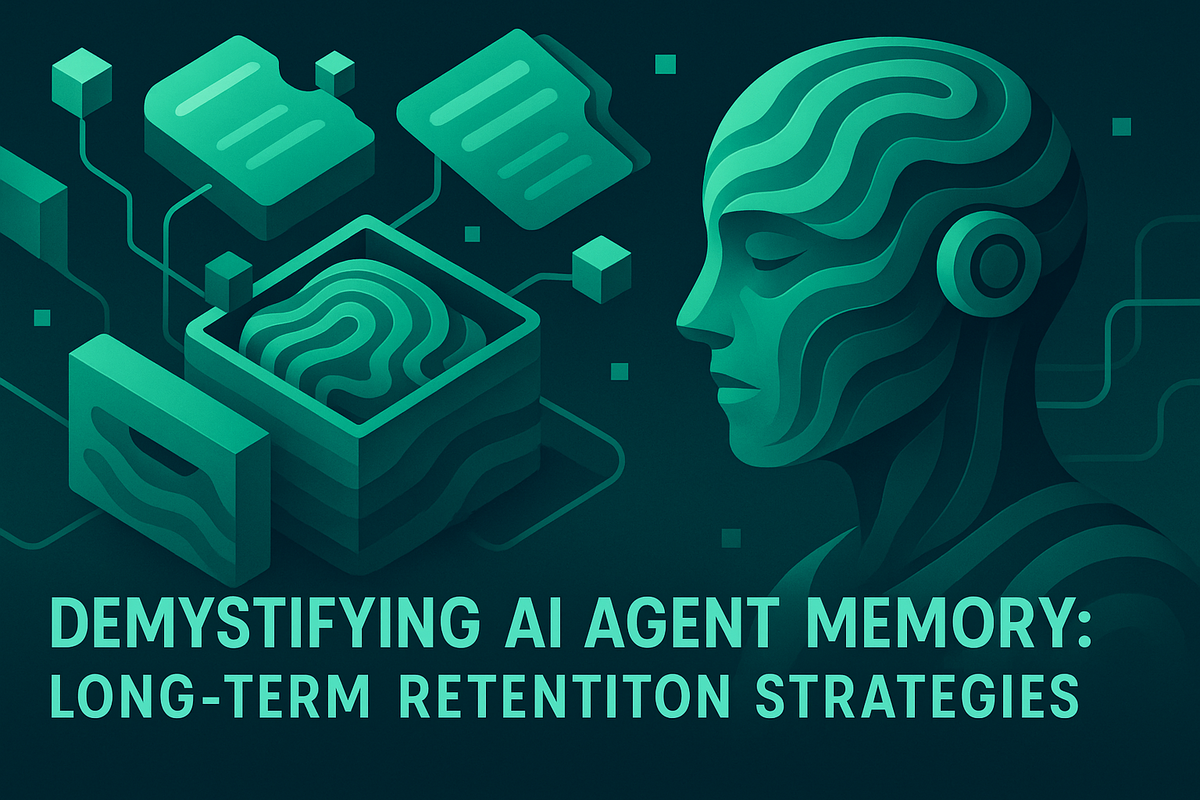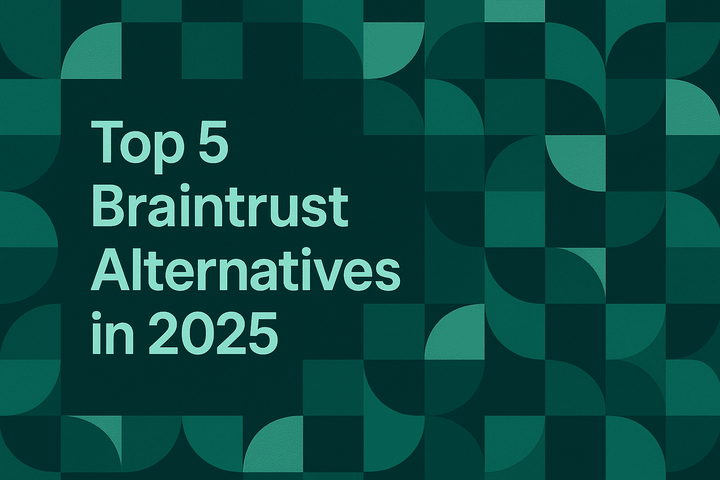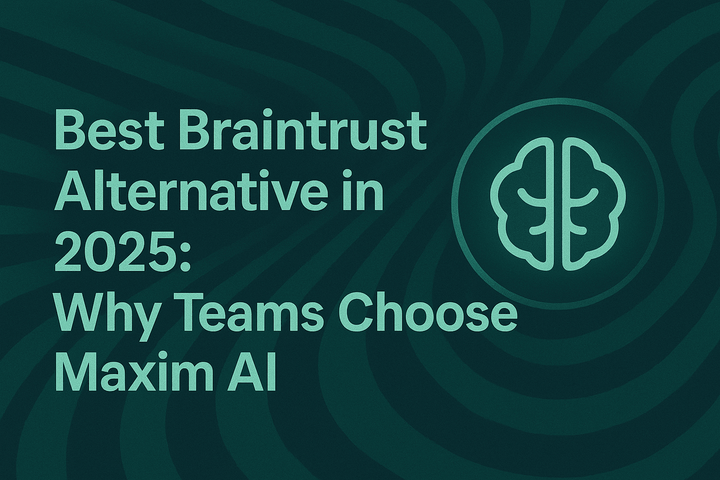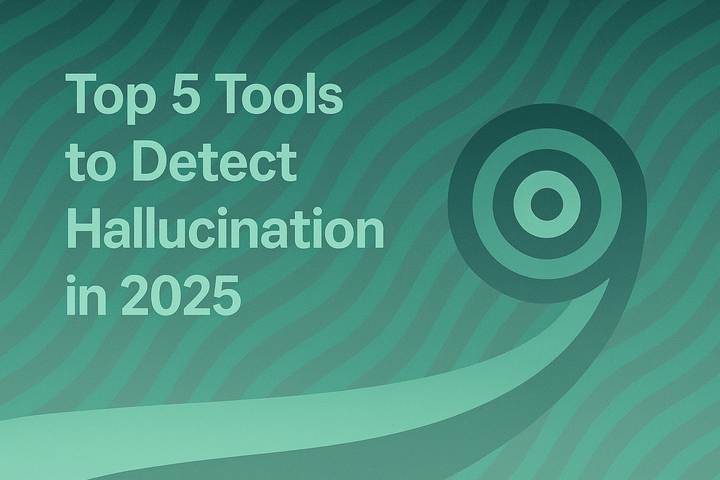Demystifying AI Agent Memory: Long-Term Retention Strategies

AI agents are increasingly expected to behave consistently, remember context, and improve over time. Yet most large language models (LLMs) operate within short context windows and stateless APIs, making durable memory and continuity non-trivial. This blog systematically unpacks what “long-term memory” means for AI agents, why it is hard, which strategies work in production, and how engineering teams can operationalize retention using evaluation, observability, and simulation. The goal is to provide a technically rigorous but accessible overview with clear implementation guidance that aligns with trustworthy AI and privacy principles.
Unpacking the AI Memory Challenge
LLMs are optimized for next-token prediction within a bounded context, not for persistent, structured memory. That creates three fundamental limitations:
- Short-term context windows. Even cutting-edge models have practical limits on token windows; once exceeded, earlier tokens drop out or are deprioritized. This constrains continuity over multi-session, multi-task workflows and hinders long-term understanding.
- Parametric vs. non-parametric knowledge. LLMs store generalizable patterns in parameters but cannot reliably update specific facts without fine-tuning. Retrieval-augmented generation (RAG) was introduced to bridge this gap by combining parametric knowledge with external non-parametric memory for knowledge-intensive tasks, enabling stronger factuality and updatability without weight changes. See the original RAG paper for the canonical formulation and results: Retrieval-Augmented Generation for Knowledge-Intensive NLP Tasks (NeurIPS 2020).
- Forgetting and drift. During agent runs or reinforcement-style updates, agents can drift away from optimal policies and forget rare but critical scenarios unless we employ replay or consolidation. Contemporary work explores replay for LLM reasoning stability and efficiency; classic experience replay in RL is a foundational technique for sample efficiency and avoiding catastrophic forgetting. For background, see Revisiting Fundamentals of Experience Replay.
In practice, these constraints manifest as brittle conversation continuity, inconsistent task execution across sessions, and difficulty reconciling new, organization-specific knowledge with frozen model parameters.
The Rise of External Memory Systems
To move beyond model-only memory, production systems rely on external stores and retrieval pipelines:
- Vector databases and knowledge graphs act as scalable, queryable, non-parametric memory. VDBs provide fast approximate nearest neighbor (ANN) search over embeddings (e.g., HNSW, product quantization), metadata filtering, and horizontal scale, critical for millisecond semantic recall at production latencies. For technical surveys and design trade-offs (storage, indexing, retrieval), see A Comprehensive Survey on Vector Database: Storage and Retrieval Technique, Challenge.
- Retrieval-Augmented Generation (RAG). RAG pipelines convert content into embeddings, store them in a vector index, retrieve relevant chunks at inference, and augment prompts with grounded context. This has been shown to improve specificity and factuality on knowledge-intensive tasks while enabling continuous knowledge updates. See the survey of modern RAG variants and evaluation frameworks here: RAG for Large Language Models: A Survey (2023–2024). For an accessible overview of RAG’s role in reducing hallucinations and enabling provenance, IBM’s primer is useful: IBM: What is retrieval-augmented generation? (source references listed on the page).
- Memorizing Transformers and non-differentiable memory modules. Some architectures augment transformers with kNN-style external memory of past key/value pairs, improving long-range recall without weight updates. See Memorizing Transformers (ICLR 2022) for evidence that such memory extensions boost performance across diverse datasets.
These external memory designs are now standard in agentic applications, particularly where agents must cite sources, align to dynamic policies, or incorporate private organizational data without model retraining.
Advanced Strategies for Persistent Retention
Beyond RAG and vector stores, teams deploy layered strategies to achieve durable memory that scales with complexity:
Memory Replay and Consolidation
- Experience replay batches and replays high-quality or rare trajectories to prevent forgetting and stabilize updates, necessary for agents that refine policies over iterative runs. Classical RL foundations provide the intuition; modern LLM reasoning adaptations demonstrate improved convergence with replay. See Revisiting Fundamentals of Experience Replay for the core mechanics.
Hierarchical Memory Structures
- Multi-granular memory organizes knowledge across levels (facts, procedures, narratives), enabling retrieval at the right abstraction. In practice, this involves curated chunking, topic taxonomies, or knowledge graphs layered over embeddings to support both precise lookups and generalization. Surveys like A Comprehensive Survey on Vector Database outline indexing strategies relevant to hierarchical design.
Self-Reflection and Selection
- Agents can meta-analyze sessions to select and summarize what to remember, scoring spans and traces by utility (task success, novelty, conflict resolution), and generating concise memory entries. Retrieval policies then prioritize high-signal memories.
- Evaluation loops quantify retention quality, does the agent use remembered facts correctly over time? Does replay reduce error rates? This is where agent evaluation, llm evaluation, and agent observability are essential in production. See Maxim’s capabilities for operationalizing these loops in the sections below.
Real-World Impact and Applications
Applied well, long-term memory transforms agent performance:
- Customer service and support. Agents recall previous tickets, preferences, and resolutions, reducing handling time and improving satisfaction while staying within policy. RAG pipelines ensure responses are grounded in the latest knowledge base articles and internal docs, with traceability for audits. The original RAG formulation demonstrates strong gains on open-domain QA tasks: RAG (NeurIPS 2020).
- Personalized tutors and copilots. Memory of skill gaps, past attempts, and feedback enables adaptive scaffolding and targeted practice. Replay ensures rare failure patterns are retained and addressed.
- Complex simulations and planning. Agents operating in multi-step workflows benefit from durable, queryable memory of constraints, environment states, and historical decisions. Memory modules like kNN-enabled transformers support long-range dependencies. See Memorizing Transformers.
To ensure reliability and trustworthiness, memory systems must be monitored for hallucination detection, drift, and privacy risks. The NIST AI Risk Management Framework offers guidance on mapping risks, measuring, managing, and governing AI systems, applicable to memory pipelines and retention policies.
Operationalizing Long-Term Memory with Maxim AI
Long-term retention is only useful if it is measurable, trustworthy, and continuously improving. Maxim AI provides a full-stack approach that covers experimentation, simulation, evaluations, and observability to make agent memory reliable at scale, without turning this into a bespoke engineering project.
Experimentation: Rapid, grounded iteration
Use Maxim’s Playground++ to experiment with RAG prompts, retrieval parameters, and memory selection policies while tracking quality, latency, and cost across model versions and configurations. Prompt engineering and prompt management are first-class, with direct database/RAG integrations.
- Explore advanced prompt engineering and deployment workflows: Maxim Experimentation.
Key capabilities for memory:
- Prompt versioning and deployment variables for comparing memory strategies (e.g., aggressive vs. conservative recall).
- Side-by-side evals across different chunking, reranking, and augmentation policies to quantify hallucination reduction and ai reliability.
- Model router and llm gateway integrations to route traffic across providers while keeping observability unified.
Simulation: Test continuity across scenarios
Simulate user journeys and agent conversations that depend on remembered context, then measure task completion, correctness, and continuity. With agent simulation and agent evaluation, teams can reproduce failures, pinpoint where memory schema or retrieval faltered, and iterate quickly.
- Build scenario-based simulations to validate retention strategies: Agent Simulation & Evaluation.
What this unlocks:
- Multi-step, multi-session simulations with agent tracing and rag tracing to visualize how memory is written, retrieved, and used.
- Re-run from any span to debug memory boundary conditions, token-window edge cases, and policy conflicts.
- Configure copilot evals and chatbot evals to benchmark end-user experience under different memory designs.
Evaluation: Quantify memory quality
Maxim’s unified evaluation framework combines deterministic checks, statistical metrics, and LLM-as-a-judge with human review for last-mile nuance. This supports llm evaluation and agent evals at session, trace, or span levels.
- Configure flexible evaluators and visualize eval runs at scale: Agent Simulation & Evaluation.
Retention-focused evaluators:
- Grounding correctness: verify retrieved context was necessary and correctly used (rag evaluation and rag evals).
- Continuity and consistency: measure whether remembered facts persist across sessions without contradiction.
- Hallucination detection: flag generations that deviate from retrieved memory or authoritative sources.
- Privacy and policy adherence: score outputs against governance rules inspired by the NIST AI RMF.
Observability: Trustworthy memory in production
In production, ai observability and agent observability are critical. Maxim’s observability suite enables distributed llm tracing and agent tracing across applications, helping teams debug memory pipelines, monitor quality, and respond to anomalies with real-time alerts.
- Monitor logs, traces, and automated quality checks in production: Agent Observability.
Operational benefits:
- Distributed tracing to connect retrieval spans, memory reads/writes, and generation decisions.
- In-production automated evals based on custom rules for rag monitoring, llm monitoring, and voice monitoring (for multimodal agents).
- Curate datasets from production traces to refine memory schemas and improve retrieval policies, a feedback loop from observability to data curation and evaluations.
Data Engine: Curate memory with precision
Long-term memory is only as good as the data behind it. Maxim’s data engine streamlines dataset import, enrichment, human-in-the-loop labeling, and continuous evolution from production logs, ideal for maintaining high-quality embeddings and metadata for memory systems.
- Curate and evolve multi-modal datasets for memory and evals: Maxim Data Engine.
Engineering Best Practices for Long-Term Retention
Implementing durable agent memory requires disciplined engineering on three fronts:
- Memory schema: Define explicit types of memory (facts, preferences, tasks, constraints). Attribute provenance, timestamps, and confidence. Index appropriately for retrieval (dense + sparse hybrid when needed) and use chunking strategies aligned with content structure (code functions, document sections).
- Retrieval policy: Start simple with top-k semantic search; add reranking, filters, and query expansion as needed. Consider session-aware retrieval and hierarchical fallback when relevant context is sparse. For deeper foundations, see RAG for Large Language Models: A Survey.
- Evaluation and observability: Instrument every stage, embedding creation, indexing, query, augmentation, generation. Use llm tracing, rag tracing, and agent tracing to link memory usage to outcomes. Adopt quality gates: grounding checks, hallucination detection, continuity tests, privacy/policy compliance referencing NIST AI RMF.
Ethical and Privacy Considerations
Persistent memory must respect user consent, retention limits, and contextual integrity. While RAG architectures reduce retraining needs, they can still retrieve sensitive information if stores are not governed properly. The NIST AI Risk Management Framework provides a structured approach to mapping and mitigating such risks with governance, measurement, and controls that apply to retention architectures. Teams should implement:
- Data minimization and purpose limitation.
- Access controls, encryption at rest and in transit, and audit trails.
- Redaction and summarization strategies for memory entries to avoid storing raw sensitive data.
- Clear deletion policies and user controls for memory opt-out.
The Future of AI Memory: Toward Hybrid Architectures
We are moving toward hybrid memory architectures that combine:
- Parametric model knowledge for generalization and language fluency.
- External non-parametric memory for freshness, provenance, and domain specificity.
- Structured memory layers (e.g., knowledge graphs) over embeddings for relational reasoning and better disambiguation.
- On-device or session-local caches for ultra-low latency recall, supported by observability and model router strategies.
Research signals continued progress on inference-time memorization and non-differentiable memory, as seen in Memorizing Transformers, and on retrieval-centric training and evaluation frameworks, as summarized in RAG survey. For engineering teams, the pragmatic path is clear: design robust memory schemas, implement disciplined retrieval, and instrument for ai quality with continuous evals and monitoring.
Ship Reliable Agent Memory Faster with Maxim
If you’re building agentic applications that must remember, reason, and improve, Maxim’s full-stack platform, spanning experimentation, simulation, evaluations, and observability, helps you move from prototypes to reliable production. Explore the product pages to see how teams use agent debugging, agent monitoring, llm observability, and ai evaluation to continuously improve memory pipelines:
Get a hands-on walkthrough and see how your agents can achieve trustworthy long-term retention with measurable outcomes. Request a demo or Sign up to get started.


